
Natural Gardening
To Spray or Not To Spray
Do I spray? That is the constant question running through the mind of the home gardener. On the one hand is the want to grow organic produce without the use of chemicals and fungicides. Deep inside there is an intuitive knowledge that tells the farmer that all the sprays and chemicals that are produced for use in controlling bugs and disease are not doing the gardener any good healthwise and are contributing to the ruination of the earth’s eco-system.
But the pain the gardener goes through when crops are disfigured by insect attack or fungal attack drive him to think about what chemicals he could use to alleviate the problem. It certainly can’t be cured with chemicals, just alleviated, and in the process an addiction to chemicals is created within the gardener.
What’s the difference between this cabbage and the one beside it?
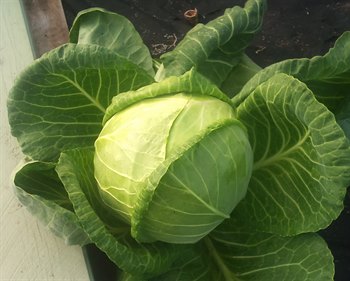
Cabbage behind insect screen

Unprotected Cabbage in the Garden
The only difference between the two cabbages is a screen around the wicking bed that keeps the insects out.

Protected crops are, in my opinion, the most effective way to grow produce and to produce quality crops that look as good as any produce grown with conventional farming methods. The biggest stumbling block for organic farming is the consumers desire to have a perfect looking piece of fruit or vegetable. Nothing else matters.
It is quite enlightening to stand in the fruit and veg section of the supermarket and watch how people pick over their choice of which one to take. Beauty is in the eye of the beholder, but I know if I have the choice between the cabbages, I will pick the cabbage without the blemishes.
So what’s the solution for growing without the use of Chemicals?
 Protected crops are definitely one solution. Not only from insects but also weather. Hail, flooding rain, excessive heat and insects can all be eliminated from the growing equation. Have a look at Cravo houses from Canada.
Protected crops are definitely one solution. Not only from insects but also weather. Hail, flooding rain, excessive heat and insects can all be eliminated from the growing equation. Have a look at Cravo houses from Canada.
These are my favourite style of protection houses as they cater mainly for crops grown in the ground. Their cost per sqm is less than glasshouses or plastic houses. Their houses have been in Australia for over seventeen years.
These houses have an opening roof and sides, which makes it more susceptible to pest pressure. The benefits of the protection still help and with the sides closed, they have found that insect numbers are reduced considerably as the majority stay closer to the ground where they have more chance of finding food and protection rather than being in the open for keen eyed birds and other predators.
 Go and have a look at them on Google Maps. Just put Sundrop Farms Port Augusta into the search bar of Maps and have a look at what comes up. If that’s not enough, go to their website. They’ve used a drone to take some magnificent aerials of their site which includes the glasshouses, their 20ha solar array and capture tower, water collection and site. It is quite mesmerising.
Go and have a look at them on Google Maps. Just put Sundrop Farms Port Augusta into the search bar of Maps and have a look at what comes up. If that’s not enough, go to their website. They’ve used a drone to take some magnificent aerials of their site which includes the glasshouses, their 20ha solar array and capture tower, water collection and site. It is quite mesmerising.
The following is an extract from their website
An everlasting supply of sunshine and sea water to grow food in arid lands
If you are a traditional farmer, you’ll need water and energy to grow your produce. And you’ll need lots of it.
The challenge is that they are finite resources that are becoming ever scarcer. Our solution? Not to use them!
We don’t extract groundwater from the planet at unsustainable rates. We don’t rely on fossil fuels. And we don’t use soil or valuable farmlands.
Instead we’ve developed technologies that integrate solar power, electricity generation, fresh water production and hydroponics. It produces an equivalent quantity of food to that grown using traditional methods, but the quality is significantly better.
 Another modern facility that is 20ha under glass in Guyra, near Armidale in NSW. The glass houses offer weather protection as much as anything and the location ensures a cold winter. A cold winter is a godsend for releiving pest pressue. Insects prefer the warmth.
Another modern facility that is 20ha under glass in Guyra, near Armidale in NSW. The glass houses offer weather protection as much as anything and the location ensures a cold winter. A cold winter is a godsend for releiving pest pressue. Insects prefer the warmth.
There are many more large glass and poly house areas throughout Australia. Originally they were built to extend the growing season and for cold protection. Now they are protecting crops in numerous ways. Combining the capital expenditure with hydroponics means big companies can get a great return on their investment as they don’t have to worry about crop rotation and fallow periods to replenish their soil.
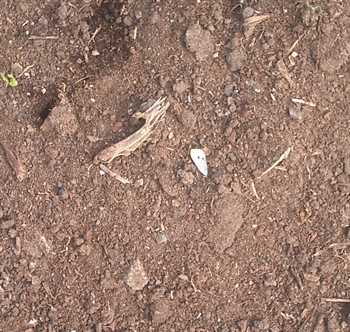 Here in Brisbane, Queensland we don’t get much of a break. I am writing this on the 6th July and the temperature today was over 25 degrees C. I happened to kill a white cabbage moth with a backhand shot using an old squash racket.
Here in Brisbane, Queensland we don’t get much of a break. I am writing this on the 6th July and the temperature today was over 25 degrees C. I happened to kill a white cabbage moth with a backhand shot using an old squash racket.
I’m still waiting for the cold snap that sorts the insects out and gives me a break from them. August and early September should see some cold snaps though.
From what I can see the future for intensive agriculture is going to be in protected houses or in factories. With the advent of low cost LED lighting that can be broadcast in any frequency of the spectrum best suited for photosynthesis we will see old factory areas close to major cities get repurposed as farms.
Hydroponic and aeroponic systems will be the preferred growing method.
Call me old fashioned but I still prefer the system that was developed without our input that we seem hellbent on destroying. Growing in the dirt and looking after the soil food web is still, hands down, the best system for growing vegetables.
This doesn’t mean my opinion won’t change over time. I can see vast increases in the quality and shelf life of hydroponically grown produce. And let’s face it, how are we going to get off planet unless we have a system for feeding ourselves.
That’s right machines don’t need nutrients like humans.

Health and Fitness, Natural Gardening

Galangal in the dirt
Growing in the dirt produces a far better crop than all of the other techniques like hydroponics, aquaponics, aeroponics and chemical gardening. Chemical gardening is a term I use for that system of growing where the dirt or sand is only a medium for holding the plants up. All of the nutrients are supplied by chemicals and the plant is defended from insects and disease with the constant spraying of chemicals.
I agree with many people that hydroponically grown plants are near perfect in appearance and present a lot better in the supermarket for the short period of shelf life they have.
But plants grown in the dirt stay fresher longer, survive a lot better out of the coolroom and just plain taste better.

Krachai being over powered by galangal and turmeric
Growing in the dirt means making your soil fit for the purpose of providing all the requirements your plants need to survive. Don’t pamper them too much as they won’t bother making any effort. A little bit of tough love is required.
Take a look at the galangal, turmeric and ginger in this garden bed. The galangal is a second year plant. I didn’t harvest it last year and this year it has really grown. I guess the proof of my assertion is the amount of rhizome harvested. So I better dig a piece up and have a look.

The ginger is all replants from the harvest last year. I have just planted more of it. This year I will keep it in the ground instead of digging it all up. That way I should have fresh ginger all year round.

The turmeric has also taken off.
Based on looking at what happens in life, plants are similar to people. If you pamper people, they don’t develop the strength that is required to cope with life. If you play in the dirt, you get exposed to all the bacteria, good and bad and the body acquires the means and know how to assimilate the good bacteria and defend against the bad.
If you live in a sterile environment, your body hasn’t developed the techniques and knowledge to defend itself when it is preyed upon by opportunistic invaders.
Peter Cundall is always playing in the dirt
Playing in the dirt and growing things is a formula for good health and longevity. Here’s a quote from Peter Cundall.

Peter Cundall at home in Tasmania.
“We are comfortably poor here, and it’s wonderful. Wealth is superb health. You get that through what I like to do – hard physical work, and the sheer joy of eating what you grow. The last time I went to the doctor because I was sick was 1951. I’m no macho man; if I had something wrong I’d be there in a flash. But every 12 months I have my tests. Last time the doctor examined me he said, ‘That’s the heart of a man of 35. I wish it was mine.’”
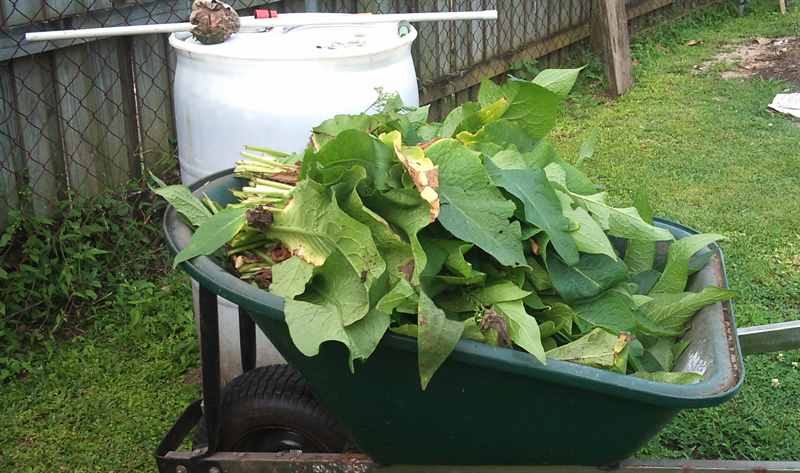
Natural Gardening
 Comfrey is a forgotten hero of the gardening world. It has a higher fertilizer analysis than most animal manures and compost. It has a tap root that goes metres into the earth and drags up minerals. I grow it at the edge of my bed as it is very good at suppressing weed and as a barrier to couch grass.
Comfrey is a forgotten hero of the gardening world. It has a higher fertilizer analysis than most animal manures and compost. It has a tap root that goes metres into the earth and drags up minerals. I grow it at the edge of my bed as it is very good at suppressing weed and as a barrier to couch grass.
No rash or itching from comfrey on me
Most articles I have read state that it causes rashes and itching if it contacts bare flesh. I must be immune as it doesn’t worry me at all. Either that or most articles are copied by people who have never touched comfrey or had the personal experience of growing it.
 The easiest way I have found to use comfrey is to shove it into a 200 litre barrel three quarters filled with water and let it sit for a few weeks with an occassional stir. A piece of electrical conduit makes a perfect stirring rod. I pulled up the wheelbarrow load and shoved it into the drum with no covering on my hands or arms. The comfrey grows quickly in the hot and wet summer here and the drum gets a wheelbarrow load every month to six weeks.
The easiest way I have found to use comfrey is to shove it into a 200 litre barrel three quarters filled with water and let it sit for a few weeks with an occassional stir. A piece of electrical conduit makes a perfect stirring rod. I pulled up the wheelbarrow load and shoved it into the drum with no covering on my hands or arms. The comfrey grows quickly in the hot and wet summer here and the drum gets a wheelbarrow load every month to six weeks.
 After letting the comfrey break down in the barrel for some time, you have to get it out. I purchased a jiggle siphon from Supercheap for $11. It was too short so I got a 13mm dripper irrigation barb joiner and added a bit of old hose.
After letting the comfrey break down in the barrel for some time, you have to get it out. I purchased a jiggle siphon from Supercheap for $11. It was too short so I got a 13mm dripper irrigation barb joiner and added a bit of old hose.
This made the hose long enough so that when the water level dropped, I could lower it further into the barrel and stop it from getting blocked by all the comfrey still breaking down in the barrel.
Comfrey is bullet proof and easy to grow and all you need to do is to dig it up or cut it in half with a spade. Leave half where it is and transplant the other half. It is like sweet potato, once you have it, you have it for life as it is practically impossible to kill.

Siphoning Comfrey Tea
I have comfrey growing in a number of locations. Where it is irrigated it grows all year round. In the dry season (winter in Brisbane) the comfrey disappears where it is not irrigated. As soon as the rain starts, it magically appears again.

Natural Gardening
Gardening is a learning curve and the best way to get better at it is to keep doing it and try and keep some records so you can look back and see what works at what time of year. You will get failures along the way, but they are one step in finding out what grows well in your area, what insects cause the most damage and experiments in trying to overcome them.
Aphids
These little suckers (in the literal sense of the word) are up there with cane toads and white cabbage butterfly as a pest that causes me to think of genocide. When you see your hard work devastated by a pest, you start to understand why the majority of farmers and gardeners turn to chemicals to rid them of the problem.
In the picture above you can see all the aphids on the Wombok growing in the wicking bed. I have sprayed them with a mixtrure of dishwashing liquid and grapeseed oil. Many sites recommend a horticultural oil, which is quite expensive. I have found that olive oil, canola oil or any cooking oil that is in the cupboard seems to do ok.
Horticultural Oil is a petroleum derivative. That’s why it is more expensive. Though with the price of oil below $50 a barrel, maybe it will become less expensive. But somehow, eating produce that has been sprayed with petroleum oil doesn’t really appeal to me.
Aphid Infestation Crop Loss
While spraying, I figured I was wasteing my time and the infestation was that bad that the only cure was to remove the infested plants. I ended up keeping two Wombok that weren’t as badly affected to see if the spraying worked. The rest went to the compost heap.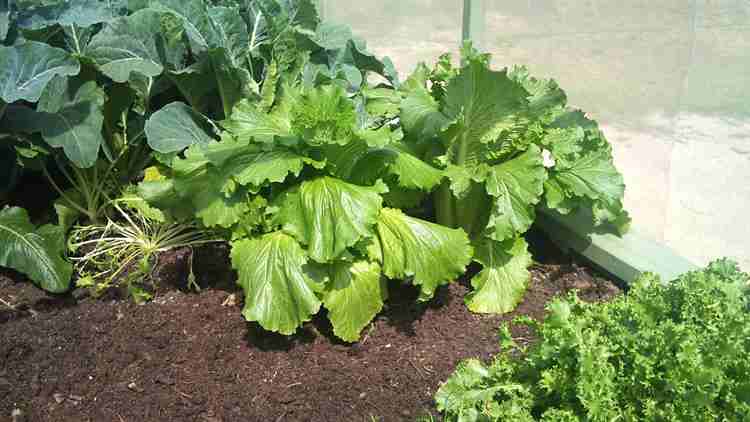
Not all Doom and Gloom
As you can see there are still plenty of vegetables left. It would appear that aphids are sweettooths, and don’t find the produce that is more on the bitter side palatable. The spinach, endive and minutina weren’t touched. Some would say that the aphids have good taste, as I would have said when I was a kid. But as it happens my taste has changed over the years and I am pleased to find non aphid infested produce.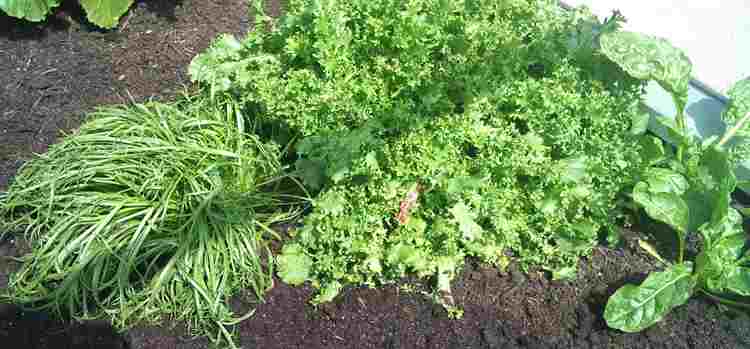
I can also verify that aphids don’t infest broad beans. Another vegetable that wasn’t on my favourite list as a child.
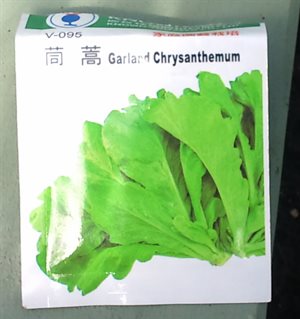 Another vegetable we use in soups and sometimes a stir fry is Garland Chrysanthemum. It is used a lot in Taiwan and I bought the seeds at an Asian grocer in Sunnybank. They are easy to grow and the aphids leave them alone.
Another vegetable we use in soups and sometimes a stir fry is Garland Chrysanthemum. It is used a lot in Taiwan and I bought the seeds at an Asian grocer in Sunnybank. They are easy to grow and the aphids leave them alone.
The lady of the house likes these so much they have all been picked.
Gardening is not always beer and skittles. But whenever you get a problem, you have a chance to use your problem solving abilities.
I have re-learned that I am not ruthless enough in the garden. Whenever I plant seeds, I find it very difficult to thin them out. I am often transplanting them or letting them all grow. This was the case with the Womboks, cabbages and cauliflowers in the wicking bed. Having them too close together has meant that the aphids have found it easy to move from one plant to the other and it is difficult to inspect the plants.
The bright side is, with the Womboks gone, there is now more room for some more of the Garland Chrysanthemum. They will be planted with good separation and culled if too close together.

Natural Gardening
I planted some Black Russian Tomatoes in the wicking bed and showed how to tie them up and prune them. These are some very strong tomato vines.
This vine has one set of roots and two laterals that I have tied with string to the overhead wire. As the vine grows, I wind it around the string and prune any more laterals that grow.
This is the other tomato in the wicking bed. The photo doesn’t show it well but the stem on these tomatoes are about 25mm (1″) thick. They are like a tree. Tomatoes have formed on the lower trusses and laterals are trying to grow on the ends of the trusses. They are vigorous vines.
I overplanted the wicking bed a little, but everything seems to be growing gangbusters. It is good to see a brassica without caterpillar damage from the white cabbage moths. I am overblessed with them in this location.
In between the tomato and the cabbage are French beans. I planted six in the wicking bed and more outside. Although some are getting smothered by the cabbages, I was able to pick 1/2 a kilo from them today. They are producing beans better in this location than out in the garden.

Natural Gardening
Like most things, gardening is a learning curve. One of the best things you can learn to do is keep a diary and record what you did and the results. It makes your life much easier next year when you decide when and what to plant.
In the picture above you can see broad beans over 2 metres high. I have been nipping the tips from them to stop their growth in height but they still seem to be getting taller. As a result, they are lodging, that’s farm speak for falling over.
These beans were planted in early April around the 12th. I can now see that I planted too early. I went back through some scrappy notes I had made and found that in 2013 I planted broad beans in mid May. I couldn’t find any notes for 2014.

I am getting some beans from the crop, but nowhere near what I expected. There will be about five kilos of beans harvested, but for the area taken and the size of the plants there should be ten times more.
To give you and idea, we are still using broad beans frozen from last years crop in soups and stews. This year I planted 20 bean seeds and this year 40. Timing is the difference between the harvest from last year and this year.
Next year will be different. I will take good notes and stagger the planting and plant 6 beans every two weeks from mid April. I will mark each group and keep a record of how they grow and the harvest. I will have growing broad beans down pat for my location in Brisbane.
I will also be quite ruthless with nipping the top out of the plants so they don’t grow so high. Just when they are starting to set beans, the late winter – early spring winds appear. Even though I had the beans supported, they still lodged in the wind.

 Protected crops are definitely one solution. Not only from insects but also weather. Hail, flooding rain, excessive heat and insects can all be eliminated from the growing equation. Have a look at Cravo houses from Canada.
Protected crops are definitely one solution. Not only from insects but also weather. Hail, flooding rain, excessive heat and insects can all be eliminated from the growing equation. Have a look at Cravo houses from Canada. Go and have a look at them on Google Maps. Just put Sundrop Farms Port Augusta into the search bar of Maps and have a look at what comes up. If that’s not enough, go to their website. They’ve used a drone to take some magnificent aerials of their site which includes the glasshouses, their 20ha solar array and capture tower, water collection and site. It is quite mesmerising.
Go and have a look at them on Google Maps. Just put Sundrop Farms Port Augusta into the search bar of Maps and have a look at what comes up. If that’s not enough, go to their website. They’ve used a drone to take some magnificent aerials of their site which includes the glasshouses, their 20ha solar array and capture tower, water collection and site. It is quite mesmerising. Another modern facility that is 20ha under glass in Guyra, near Armidale in NSW. The glass houses offer weather protection as much as anything and the location ensures a cold winter. A cold winter is a godsend for releiving pest pressue. Insects prefer the warmth.
Another modern facility that is 20ha under glass in Guyra, near Armidale in NSW. The glass houses offer weather protection as much as anything and the location ensures a cold winter. A cold winter is a godsend for releiving pest pressue. Insects prefer the warmth. Here in Brisbane, Queensland we don’t get much of a break. I am writing this on the 6th July and the temperature today was over 25 degrees C. I happened to kill a white cabbage moth with a backhand shot using an old squash racket.
Here in Brisbane, Queensland we don’t get much of a break. I am writing this on the 6th July and the temperature today was over 25 degrees C. I happened to kill a white cabbage moth with a backhand shot using an old squash racket.






















